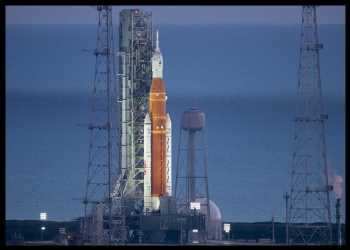Second Attempt To Launch Giant Moon Rocket Set For September 3
On September 3, NASA will make a second attempt to launch the giant Moon rocket carrying Orion spacecraft for the Artemis I mission.
The 322-foot-tall stack, consisting of the Space Launch System rocket and Orion spacecraft, is re-scheduled to launch from Kennedy Space Center in Florida at 2:17 p.m. ET, the beginning of a two-hour window.
The historic maiden test flight, originally scheduled for Monday, was abandoned after encountering an issue with one of the four RS-25 engines on the bottom of the rocket’s core stage.
During that launch attempt, teams were not able to chill down engine 3 to approximately minus 420 degrees F. The engineers also detected a hydrogen leak on a component of the tail service mast umbilical quick disconnect, and managed it by manually adjusting propellant flow rates.
Mission managers met Tuesday to discuss data and develop a forward plan to address issues that arose during the launch attempt.
In the coming days, teams will modify and practice propellant loading procedures to follow a procedure similar to what was successfully performed during the Green Run at NASA’s Stennis Space Center in Mississippi. The updated procedures would perform the chill down test of the engines, also called the kick start bleed test, about 30 to 45 minutes earlier in the countdown during the liquid hydrogen fast fill liquid phase for the core stage, NASA said in its latest update.
Meteorologists with the U.S. Space Force Space Launch Delta 45 predict favorable weather conditions for Saturday. While rain showers are expected, they are predicted to be sporadic during the launch window.
The mission management team will reconvene Thursday to review data and overall readiness.
The Artemis I test flight with no crew on board is aimed at laying the foundation for a sustained long-term human presence on and around the Moon.
Artemis 2 and 3 missions aims to send astronauts back to the lunar surface for the first time after half a century.
In future Artemis missions, which are set to take place in this decade, NASA has promised to land the first woman and first person of color on the Moon, using innovative technologies to explore more of the lunar surface than ever before.
Source: Read Full Article

